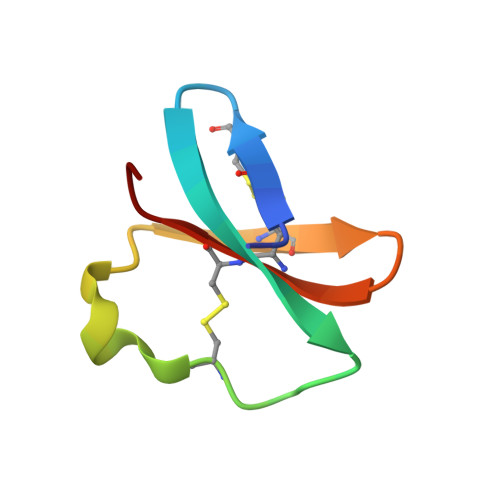Solution structure of APETx2, a specific peptide inhibitor of ASIC3 proton-gated channels
Chagot, B., Escoubas, P., Diochot, S., Bernard, C., Lazdunski, M., Darbon, H.(2005) Protein Sci 14: 2003-2010
- PubMed: 15987885
- DOI: https://doi.org/10.1110/ps.051378905
- Primary Citation of Related Structures:
1WXN - PubMed Abstract:
Acid-sensing ion channels (ASIC) are proton-gated sodium channels that have been implicated in pain transduction associated with acidosis in inflamed or ischemic tissues. APETx2, a peptide toxin effector of ASIC3, has been purified from an extract of the sea anemone Anthopleura elegantissima. APETx2 is a 42-amino-acid peptide cross-linked by three disulfide bridges. Its three-dimensional structure, as determined by conventional two-dimensional 1H-NMR, consists of a compact disulfide-bonded core composed of a four-stranded beta-sheet. It belongs to the disulfide-rich all-beta structural family encompassing peptide toxins commonly found in animal venoms. The structural characteristics of APETx2 are compared with that of PcTx1, another effector of ASIC channels but specific to the ASIC1a subtype and to APETx1, a toxin structurally related to APETx2, which targets the HERG potassium channel. Structural comparisons, coupled with the analysis of the electrostatic characteristics of these various ion channel effectors, led us to suggest a putative channel interaction surface for APETx2, encompassing its N terminus together with the type I-beta turn connecting beta-strands III and IV. This basic surface (R31 and R17) is also rich in aromatic residues (Y16, F15, Y32, and F33). An additional region made of the type II'-beta turn connecting beta-strands I and II could also play a role in the specificity observed for these different ion effectors.
Organizational Affiliation:
Architecture et Fonction des Macromolécules Biologiques, Centre National de le Recherche Scientifique, Unité Mixte de Recherche 6098, Universités d'Aix-Marseille I and II, Marseille Cedex 20, France.














